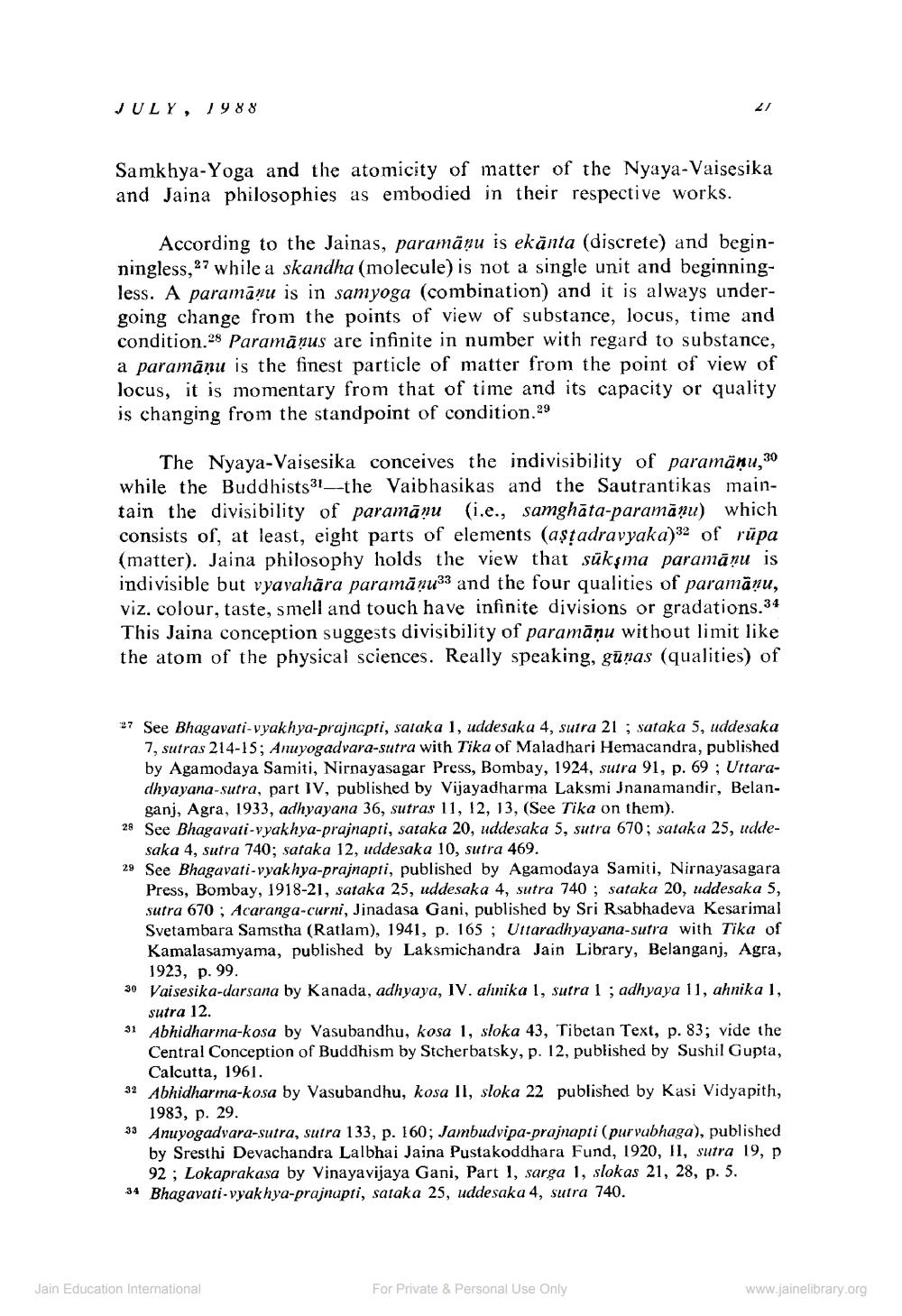________________
JULY, 1988
Samkhya-Yoga and the atomicity of matter of the Nyaya-Vaisesika and Jaina philosophies as embodied in their respective works.
According to the Jainas, paramānu is ekānta (discrete) and beginningless, 27 while a skandha (molecule) is not a single unit and beginningless. A paramānu is in samyoga (combination) and it is always undergoing change from the points of view of substance, locus, time and condition.28 Paramāņus are infinite in number with regard to substance, a paramāņu is the finest particle of matter from the point of view of locus, it is momentary from that of time and its capacity or quality is changing from the standpoint of condition.29
The Nyaya-Vaisesika conceives the indivisibility of paramāņu,30 while the Buddhists 31-the Vaibhasikas and the Sautrantikas maintain the divisibility of paramānu (i.e., samghāta-paramāņu) which consists of, at least, eight parts of elements (așțadravyaka)32 of rupa (matter). Jaina philosophy holds the view that sükşma paramānu is indivisible but vyavahāra paramāņu33 and the four qualities of paramānu, viz, colour, taste, smell and touch have infinite divisions or gradations.34 This Jaina conception suggests divisibility of paramāņu without limit like the atom of the physical sciences. Really speaking, günas (qualities) of
27 See Bhagavati-vyakhya-prajnopti, sataka 1, uddesaka 4, sutra 21 ; sataka 5, uddesaka
7, sutras 214-15; Anuyogadvara-sutra with Tika of Maladhari Hemacandra, published by Agamodaya Samiti, Nirnayasagar Press, Bombay, 1924, sutra 91, p. 69 ; Uttaradhyayana-sutra, part IV, published by Vijayadharma Laksmi Jnanamandir, Belan
ganj, Agra, 1933, adhyayana 36, sutras 11, 12, 13, (See Tika on them). 28 See Bhagavati-vyakhya-prajnapti, sataka 20, uddesaka 5, sutra 670; sataka 25, udde
saka 4, sufra 740; saraka 12, uddesaka 10, sutra 469. 29 See Bhagavati-vyakhya-prajnapti, published by Agamodaya Samiti, Nirnayasagara
Press, Bombay, 1918-21, sataka 25, uddesaka 4, sutra 740; sataka 20, uddesaka 5, sutra 670 ; Acaranga-curni, Jinadasa Gani, published by Sri Rsabhadeva Kesarimal Svetambara Samstha (Ratlam), 1941, p. 165 ; Uttaradhyayana-sutra with Tika of Kamalasamyama, published by Laksmichandra Jain Library, Belanganj, Agra,
1923, p. 99. 30 Vaisesika-darsana by Kanada, adhyaya, IV. ahnika 1, sutra 1 ; adhyaya 11, ahnika 1,
sutra 12. 31 Abhidharma-kosa by Vasubandhu, kosa 1, sloka 43, Tibetan Text, p. 83; vide the
Central Conception of Buddhism by Stcherbatsky, p. 12, published by Sushil Gupta,
Calcutta, 1961. 32 Abhidharma-kosa by Vasubandhu, kosa II, sloka 22 published by Kasi Vidyapith,
1983, p. 29. 33 Anuyogadvara-sutra, sutra 133, p. 160; Jambudvipa-prajnapti (purvabhaga), published
by Sresthi Devachandra Lalbhai Jaina Pustakoddhara Fund, 1920, II, sutra 19, P
92 ; Lokaprakasa by Vinayavijaya Gani, Part 1, sarga 1, slokas 21, 28, p. 5. 34 Bhagavati-vyakhya-prajnupti, sataka 25, uddesaka 4, sutra 740.
Jain Education International
For Private & Personal Use Only
www.jainelibrary.org




